SUMMER CHALLENGES
Difficult time for our whole industry
by TurfPro Editor, Laurence Gale MSC, MBPR
It is fair to say the whole country is experiencing one of the longest spells of hot, dry weather for many years - creating particular problems for turf professionals.
It is fair to say the whole country is experiencing one of the longest spells of hot, dry weather for many years. This weather front came in towards the end of April on the back of one of the wettest, coldest springs for many years. The combined effect of this, has been a very challenging time for our whole industry.
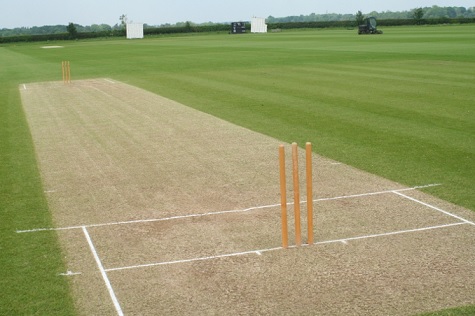
Most Cricket groundsmen faced a stern challenge to get their squares ready for the start of play, largely due to the fact that many grounds where lying wet/ saturated preventing the onset of any decent spring renovation work before play began in April. The weather then turned completely on its head and we ended up with areas of high pressure bringing in this current long spell of hot, dry weather.
For me this year has similarities with one of the hottest summers on record, when back in 1976 the whole country became tinder dry.
Back then not many golf courses and sports grounds had the benefit of automatic irrigation systems - it was a case of hand watering with hose pipes.
I remember weeks and weeks of constantly watering our greens just to keep them alive. However, today most if not all golf courses and top flight sports grounds have access to automated irrigation systems.
Having said that, the cost of watering will be a factor to consider this year - and hosepipe bans will become a factor to be reckoned with.
However, away from the top end professional clubs, universities and schools many grass root sports clubs and local authority pitches will be at the mercy of this weather. With many pitches becoming bone hard and dry, with most grass browning off and going into a dormant stage.
For these clubs it is a case of grin and bare it until we get some much needed rainfall.
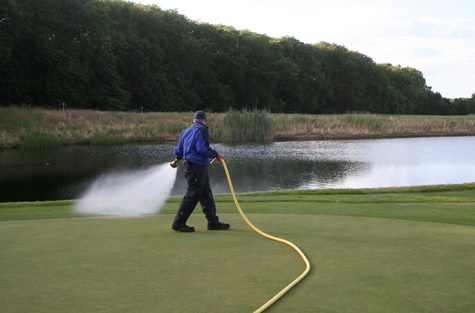
However, there are some turf management steps to help reduce drought stress, such as changing cutting heights, use of organics, wetting agents, spiking regimes and effective use of water whilst it is available. Early, preventative action is critical, as there are limited things you can do once the drought is underway.
Try and keep as much grass cover as possible, raise the height of cut by a few millimetres. Control warm up and training activates by rotating them around different areas of the pitch to reduce wear.
Ensure you cut the grass with sharp mowers, leaving a clean cut. The use of plant growth regulators (PGR) can be a useful tool to help the plant combat drought conditions. PGRs will slow the plants growth thus reducing the need to cut so often. However, a programme of growth regulators is not cheap.
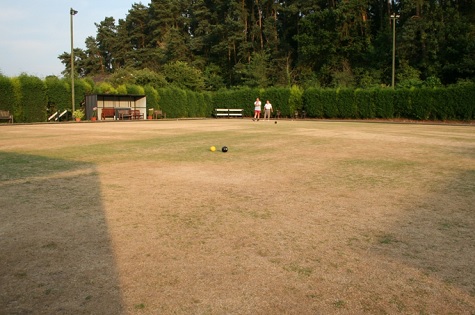
Depending on the soil type, some pitches will dry out at different rates; sandy soils will be very quick to dry out, whereas clay soils retain moisture and are more likely to help sustain plant growth over a longer period. There may be a need to cancel games if the pitches become too hard. However, grass is a very resilient plant and will recover quite quickly once it receives adequate moisture.
If you are able to water, please ensure you conserve and do not waste it. Do not irrigate during the hottest part of the day, you will lose most of the water you are trying to put on by evaportranspiration; irrigate in the evenings, and also ensure you water to depth.
When choosing an irrigation system you will need to get some advice on which one will suit your needs, generally this will be dependent on what water resources you have available. Are you on mains water, borehole or extracting from a river/pond resource? You will need extraction licences to take water from boreholes, lakes and rivers.
Many self-travelling sprinklers require a certain pressure of water to operate effectively. Irrigation equipment is an essential tool for managing natural turf pitches.
One sure way of helping to rejuvenate your pitches is to carry out some autumn renovation work. We should hope that by September we will have had some favourable wet weather to soften up the pitches.
It is then a case of lightly scarifying in two directions to clean out any dead grasses/ fibre. Aerating to a depth of 150-220mm, top dressing, applying an autumn feed and oversowing.
I hope you continue to enjoy this wonderful challenging warm weather and make the most of it while it lasts.
 |
|
 |  |
BALLYMENA ANGER OVER NEW PITCH DAMAGE
Stock cars tear up surface again
Race cars have once again driven over Ballymena United's pitch, leading to anger from the club's officials.
You may remember TurfPro reported back in January the anger felt by Irish Premiership team Ballymena United when the co-users of the Showgrounds where they play, damaged the pitch via stock car racing which also takes place at the venue.
Unfortunately for the football club a similar incident happened again on Friday night (20th July) which was widely reported in the media.
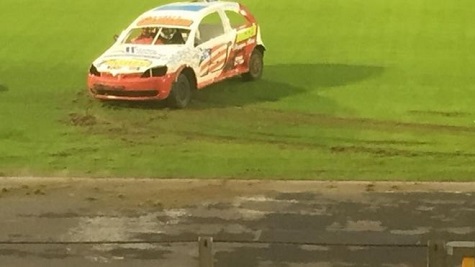
Ballymena United Tweeted out pictures of the damage
The Belfast Telegraph reported that the chairman of Ballymena United has said the club's confidence in Mid and East Antrim Council has been "unfortunately dashed" after their newly laid pitch was cut up once again.
The paper says that in an open letter to fans, John Taggart spoke of his "total disappointment" that parts of the surface had been gouged.
It is estimated that a total of £250,000 has been spent on the new surface.
Mr Taggart said fears of damage had been raised by supporters and club members just over a month ago.
In the statement, he added: "At the AGM, concerns were raised at great length by shareholders about what efforts would be in place to protect the pitch from damage.
"Supporters were particularly vociferous that the council should not allow damage to the playing surface after such a capital spend of ratepayers' money."
In an interview with the BBC, Ballymena United's vice-chairman Don Stirling said, "Stock cars have every right to be there" but the two sports are "just not compatible".
He continued, "I honestly don't know what the solution is, but the council have to be held responsible.
"They can't keep cars off the pitch because if they veer off the track they have nowhere to go.
"They put down truck tyres (on Friday night) but they would have need massive tractor tyres to stop cars coming on the pitch."
However the BBC also interviewed Aubrey Arbuthnot, who runs Ballymena Raceway, who told them he was "fed up" with criticism directed at the race events and that he had done as much as he could to keep cars off the pitch.
"All I want is fair play. I'm a ratepayer, not like some of the people sounding off in the press," he said.
"We had 12 races last night. These cars race door handle to door handle. There's up to 60 cars racing. Only two cars went off the track in separate incidents."
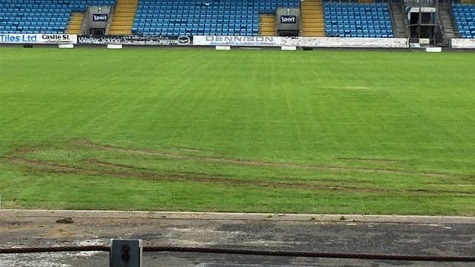
The BBC showed the damage to the pitch the morning after the stock car racing
A spokesperson for the council told the BBC, "We are deeply disappointed by last night's incident and fully appreciate and understand the frustration around this.
"Ballymena Showgrounds is a multi-use facility, enjoyed by a wide range of local sporting organisations.
"The measures put in place to protect the new surface at the venue were inadequate for last night's event.
"Remedial works are being carried out on the pitch today.
"As the owners of the venue, we are fully committed to doing all that we can to safeguard the new pitch, and we are considering a range of measures to minimise the risk of damage to the surface as a matter of urgency."
 |  |
AMENITY FORUM RELEASE ANNUAL STATEMENT
Available for download
"What happens in amenity management impacts upon every UK citizen every day," says Amenity Forum's chairman John Moverley.
The Amenity Forum has published its Annual Statement which is available now to download.
It covers the 12 months running up to June 30th 2018 and demonstrates the wide range of activity and development of this unified voice for the sector on all aspects of weed, pest and disease management. Organisations signed up to the Forum and committing themselves to best practice continues to grow and covers all areas of this diverse but highly important sector.
In reporting on key achievements, John Moverley, the Chairman, is keen to focus on what lies ahead and the need for everyone to embrace the Forum’s objectives. In the report, he says, "This has certainly been a year full of change, challenge and opportunity and all is set to continue at even greater pace. There is much going on at policy level with the Government publishing its 25 year environmental plan and ongoing consultations about its implementation and impact".
In looking forward, the Forum identifies the following key priorities:
- Continuing activity to further increase understanding of our sector, not just by the public but by key stakeholders and all involved
- Further developing understand of Integrated approaches and what they really mean
- Ensuring the sector can maintain its current ability to manage weeds, pests and diseases and maintain the high standards and safe use of all sports surfaces and amenity areas
- Continuing to increase those engaged in continuing professional development and develop and promote strongly the importance of Assured standards
John says "The UK amenity sector sets a very high standard and is proud of its achievements. The Forum will continue to seek that all involved are at such standard and that everyone understands the importance and vital nature of this sector."
This year’s Forum annual conference and exhibition has the theme ‘Change, Challenge and Opportunity’. It will be held once again at the Pirelli Stadium, Burton upon Trent, on Tuesday, October 9th
Delegate rates are £75 + VAT for supporter organisations and £85 + VAT for others. However there is a £10 discount for early bird registrations before September 1st
For further information, go to the website at www.amenityforum.co.uk/conference/the-amenity-forum-conference-2018 and to register, contact Kate at admin@amenityforum.net
 |  |
CRICKET RENOVATION DATE ANNOUNCED
By Dennis & Sisis
Event will be held at Cheltenham College on 7 August and those wishing to attend are encouraged to register soon to avoid disappointment.
Dennis and SISIS have announced the date for their cricket renovation day for 2018.
The event will be held at Cheltenham College on 7 August and those wishing to attend are encouraged to register soon to avoid disappointment.
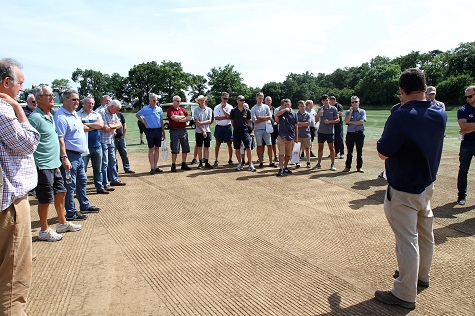
Pitch scarification workshop
Since 2011, the Dennis and SISIS series of seminars have seen over 1200 cricket groundsmen in attendance, bringing together volunteers and professionals representing test and 1st class venues, club cricket, schools, colleges and universities.
The August event at Cheltenham College, will be a mix of thought provoking indoor presentations and discussions with outside practical demonstrations - with plenty of time built into the programme for speaking with fellow groundsmen. There will also be a number of high profile, well respected industry sponsors in attendance offering support and advice.
“Following the highly successful seminar held at The Brightside Ground, Bristol in 2017, the decision to return to Gloucestershire to continue our 'For the groundsmen by the groundsmen' series of educational seminars was a relatively straightforward one and we hope delegates find the event informative, but above all enjoyable,” commented Roger Moore, sales and marketing manager at Dennis and SISIS.
The day includes a talk on profile reading and autumn renovations from turf consultant Alex Vickers and an overview on renovations from contractor Keith Exton of Perfect Pitches.
The morning will finish with a soil core clinic led by Keith, Alex and Ian Smith, turf consultant from St Albans School.
After a complimentary lunch, groundsmen can attend two practical sessions; one on end of season renovations and the other on aeration. Cheltenham College head groundsman Christian Brain and Robert Jack (Dennis and SISIS) will join the delivery team for the first of those while Jason Briggs from Dennis and SISIS will lead the final session alongside Keith Exton.
The day will end with a question and answer session with the panel of experts.
Attendance to this informative seminar is free and seats are expected to be filled extremely fast.
To register your interest contact Roger Moore at Dennis & SISIS on 01332 824777 or email Roger on roger.moore@dennisuk.com
 |  |
EGO PUBLISHES WHITEPAPER
On lithium-ion battery verses petrol powered outdoor equipment
Cordless outdoor power equipment manufacturer EGO has published a new whitepaper that looks at the benefits of lithium-ion battery versus petrol powered outdoor equipment.
Cordless outdoor power equipment manufacturer EGO has published a new whitepaper that looks at the benefits of lithium-ion battery versus petrol powered outdoor equipment.
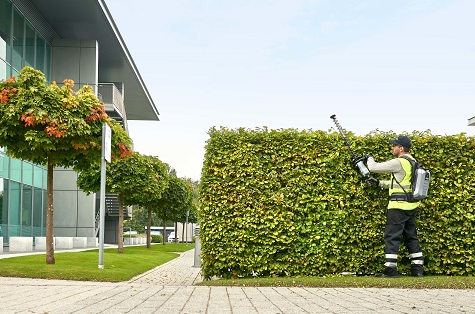
Steve Roskell, marketing director (EMEA) of EGO said, “In the world of professional landscaping and grounds maintenance, petrol has been the fuel of choice for over 100 years - mainly because there has been no viable challenger. Recently however, battery powered cordless equipment has begun to gain worldwide popularity and increased market share, signalling the most significant shift in the sector for decades.”
EGO say there are four key factors driving this trend: health & safety, user comfort, the environment and economics, all of which are outlined in a dedicated whitepaper commissioned by themselves, which looks at how to increase safety, productivity, sustainability and cost-effectiveness in commercial gardening.
EGO say their whitepaper provides “extensive evidence of the potential risks posed by petrol to user health and the environment and the benefits of battery powered tools to company cashflow”.
Steve continues, “In each of these areas, the benefits of lithium-ion batteries over petrol are overwhelming. Moreover, the emergence of new generation batteries and equipment by global manufacturers such as EGO means that lithium-ion batteries can now match or even surpass the performance of petrol, without any of the drawbacks.”
To download the whitepaper via the EGO Power Plus website visit egopowerplus.co.uk/whitepaper
 |  |
GGM CELEBRATE WITH GOLD
Kubota award for Service Excellence
GGM Groundscare have been awarded the Kubota Gold award for Service Excellence for the 7th year running.
GGM Groundscare say they are delighted to have been awarded the Kubota Gold award for Service Excellence for the 7th year running.
The award which was set up by Kubota UK in 2003 with a goal of improving the standards a customer can expect to receive is something dealers strive to achieve.
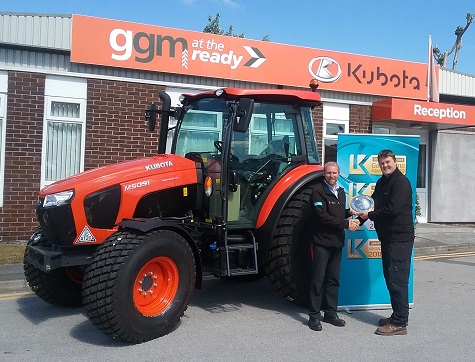
L-R: Mark Lewin (aftersales manager, GGM) & Tom Lockwood (regional service representative, Kubota)
The prestigious award is measured on an annual basis against a strict measuring system across various measuring tools including: customer satisfaction surveys, mechanical training and workshop / service facilities.
Mark Lewin, After-Sales Manager at GGM said, “We continually work incredibly hard all year to ensure we consistently work to the highest standards that are required to be awarded the Kubota Gold award. Customers are at the forefront of everything we do at GGM and awards like this offer customers the reassurance that their machine is in safe hands”.
Operating from depots in Colne covering Yorkshire & Lancashire & Haydock covering Greater Manchester, Cheshire, Merseyside, GGM are well set up to service customers across the area whether they are looking for a new machine, a service or spare parts. GGM now employs 31 staff including an experienced team of 18 in the after-sales department.
GGM’s association with Kubota stretches back over 40 years to 1976 when Michael Gibson purchased a horticultural dealer business at Highgate near Kirkham in Lancashire.
Current Managing Director at GGM Chris Gibson, his son, comments, “My father was always looking for new ideas, so when he purchased the business in 1976 it’s not surprising that he soon spotted a new product that would revolutionise the way horticultural growers worked in Glass houses, namely the Kubota Compact Tractor. After discussions with John Croft the sales agent for Kubota at the time, he became the first dealer to sign up and the Contract tractor business in the UK was born.”
 |  |
WOLVES PUT TRUST IN ICL
Praise for granulars
Wayne Lumbard, Head Groundsman at Wolverhampton Wanderers FC belives the pitch is at the best it has ever been throughout his thirteen-year tenure at the club.
Wayne Lumbard, Head Groundsman at Wolverhampton Wanderers FC has reason to celebrate. Not only has the team been promoted to the Premier League, but in his opinion the pitch is at the best it has ever been throughout his thirteen-year tenure at the club - with a little help from ICL.
It is safe to say that Wayne has experienced some highs and lows at the club. However, after being relegated twice, optimism at the club is now at an all-time high.

“Collectively, what everyone at the club has done has been the main ingredient behind our success,” he says. “The football has been the best I’ve ever seen here the pitch has been consistently great all season - everything on and off the pitch has just clicked.”
Wayne acknowledges that the relatively new owners have been instrumental in Wolves’ rise back to the highest heights of English football, and they have certainly signalled some substantial improvements.
Last year, a state-of-the-art Desso Grassmaster hybrid pitch was installed at the Molineux Stadium and after being hugely impressed, the owners sanctioned three more to be built at the Sir Jack Hayward Training Centre in Compton Park.
With a completely new stadium pitch to work with, Wayne chose to adhere to a granular fertilizer programme from ICL.
“It was our first season on the new pitch at the stadium so it was a case of testing the products but the programme worked so well. I am confident that we now have everything down to a tee,” he said.
“Straight from renovation and two weeks after seeding, I applied SierrablenPlus Renovator 20-20-8 as a base feed at a rate of 30 g/m² and continued to apply this all the way through the season until the final game of the season.
“After the initial base feed, it was a case of applying the spring and summer fertilizers at the correct time. We had huge success with Greenmaster Pro-Lite NK 12-0-12 which we applied at 30g/m2 before we moved into Autumn with Greenmaster Pro-Lite Double K at 30g/m2 because we needed more potassium than nitrogen at that time of year. Into winter, we decided to go with a Greenmaster Pro-Lite Invigorator 4-0-8 at 30g/m2 while still continuing with regular feeds of ProTurf 20-0-7 at 25g/m2 - which we had been applying since June.
“It is all about applying the right products at the right time and in the right place. Personally, I think what is more important than anything, is the overlap of the products so that you have that even line of consistency throughout the season.
“With the pressures that groundsmen are under today with having to produce a pitch for match day, I want guarantees and that is what I get with ICL. Quite simply, they are products that I can trust and along with the back-up assistance I receive from Emma Kilby (ICL Technical Area Sales Manager) is as good as the products themselves.
“I sit down with Emma at the end of each season, we look at the iTurf programme we had in place and how the pitches at the stadium and training ground performed. At this stage, if we need to make any tweaks to our programme, then we will. Based on the last twelve months, I can’t see us making too many changes - the pitches have performed fantastically well and along with the grounds team, ICL products have played their part in our success.”
 |  |
TURNEY DELIVERS FOR BLENHEIM PALACE
Ransomes MP495 cylinder mower chosen
Purchase is a continuation of the long-standing relationship between Ransomes, The Turney Group and Blenheim Palace.
Blenheim Palace, located in Oxfordshire, and the birthplace of Sir Winston Churchill, has taken delivery of a Ransomes MP495 cylinder mower to maintain its prestigious gardens.
Delivered by local dealer The Turney Group, this purchase is a continuation of the long-standing relationship between Ransomes, The Turney Group and Blenheim Palace.
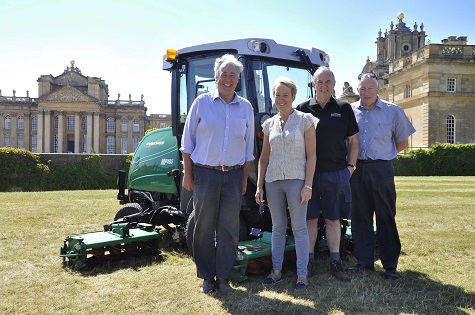
L-R: Robert Millar, area sales manager, The Turney Group, Hilary Wood, head of gardens at Blenheim Palace, Trevor Wood, operator at Blenheim Palace, Bernard Guilford, area sales manager, The Turney Group
Blenheim Palace is the principal residence of the Dukes of Marlborough, and the only non-royal English country house to hold the title of ‘palace’. The Palace was designated a UNESCO World Heritage Site in 1987 and welcomes around 800,000 visitors every year.
Hilary Wood, Head of Gardens at Blenheim Palace, manages a team of 10 full-time and six part-time staff who are tasked with manicuring 120-acres of gardens, and some of the 2000-acres of parkland across the 12,000-acre estate.
“We have a lot of land to maintain at Blenheim Palace, and it’s important that we have the correct machinery for the job,” Hilary said. “We have been using Ransomes ever since I first arrived in 1981; so more than 37 years. We have had Ransomes Commander mowers in the past, which have been brilliant, and we have now opted for the new Ransomes MP495, which we have been using since April, and it has exceeded all expectations.
“We have a very happy relationship with our dealer; it’s a family-run business and we receive a very friendly, personalised service. We can always rely on them to be with us whenever we need them, which is something we haven’t had from other suppliers in the past. The Turney Group always let us demo a machine over a period so that we can try it in various conditions and make an informed decision. This gives us confidence in the purchase we make.”
 |  |
LARGS OPTS FOR INFINICUT
Bowls club purchases 22” model
Investment in new machine makes club one of the first bowls outfits in Scotland to own one.
Largs Bowling Club is home to one of the largest greens in the west of Scotland, comfortably able to accommodate eight rinks in either direction.
In charge of the day-to-day upkeep is greenkeeper, Ron Hempseed, who can be found watering, brushing and mowing the green six mornings a week. He says his job has been made all the more pleasurable after the club purchased a Cub Cadet 22” INFINICUT from MTD Specialty Turf Products in April this year, making them one of the first bowls clubs in Scotland to have one.
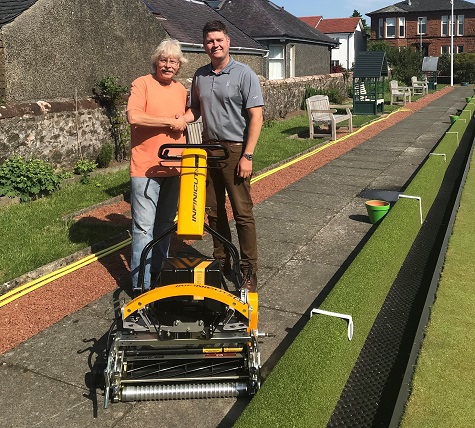
Ron Hempseed of Largs (left) with Dougie Archibald of MTD Specialty Turf Products and their new INFINICUT
“Our previous mower was in need of a new cylinder and when we went out to price this up we decided it would be better to invest our money in a new machine” explained Ron, who has been a member of Largs BC for over 30 years. “As a committee we looked at a straight replacement of our previous mower, and because it was different we investigated the Cub Cadet INFINICUT.”
They first heard about the machine through contractors Pro-Turfcare who work alongside Ron, conducting the more complex monthly maintenance. “They were in the process of purchasing one and suggested we speak to MTD’s Dougie Archibald to come in and give us a demonstration. The Club President, Vice President and members of the committee all attended and were able to ask plenty of questions. The fact it had a floating head, removing the need for a separate groomer attachment, was a big plus point for us - as was the fact it is battery powered, keeping noise down to a minimum for our neighbours.
“We’ve had so many comments on how the green is both looking and playing, including from Pro-Turfcare who see a variety of different surfaces in a day. It’s been a cracking machine so far, backed up with great support from Dougie and Jonty the technician - we’re very impressed!”
 |
|
 |  |
ADVERTISE YOUR JOBS HERE
Amazing success rates!
Advertise your recruitment needs on TurfPro Weekly Briefing and reach our targeted audience of recipients every week.
Contact Susan Pallett for details - 01491 837117
|
SHOWCASE YOUR NEW PRODUCTS HERE
Have your new equipment seen first!
Use this Weekly Briefing to showcase your new products to our ever-growing community of specialist dealers.
Contact Susan Pallett - 01491 837117
|
 |  |
 |  |
 |  |
 |  |
HOLLOW CORING & DEEP SCARIFICATION
Is it really necessary?
by Martin Ward, Symbio
The wisdom of losing a week’s income for maintenance week this autumn . . .
The USGA rootzone specification for greens construction and top dressing was developed nearly 60 years ago. It was designed to be managed with the technology of the time with a high input of inorganic fertilisers and powerful pesticides many of which are now banned. Many agronomists still recommend high inputs of sand, invasive aeration and scarification for thatch removal and programmed chemical management with growth regulators and high fungicide inputs as a way of managing these greens and pitches, in effect promoting 60-year-old technology.
Many greenkeepers and club managers find these outdated practices are no longer viable due to cost, lost play, golfer dissatisfaction and stress on the greenkeeper. It is time for the turf industry to move forward.
The USGA specification for construction and top dressing provides an excellent base from which to work with new techniques developed to remove the need for hollow coring and intensive scarification, improve drainage when wet and water retention when dry, reduce fertiliser and fungicide inputs and reduce the time greenkeepers spend on managing grass growth.
Where it’s going wrong
Compaction leading to poor infiltration rates, a build-up of thatch and anaerobic conditions are inbuilt design flaws of heavily used sand based golf greens and sports pitches. Most current thinking suggests that a physical solution to compaction is the only answer; consequently, a lot of the turf manager’s time and budget is taken up by the physical removal of thatch and hollow coring and top dressing with up to 200 tonnes of sand p.a. to dilute thatch, improve drainage and relieve compaction. This is time consuming, expensive, disruptive, uses finite resources, temporarily reduces the enjoyment of the game and results in lost play and lost income for the club.
Longer term, heavy top dressing stores up problems for later years, the organic material may become buried below the reach of most tines so oxygen is not available to convert it aerobically to humus, leading to root breaks and black layer. Heavy top dressing also dilutes the plant nutrients N,P, K, Ca, S, Mg, Cu, B, Zn, Mn, and reduces Cation Exchange Capacity (the nutrient holding capacity of the rootzone) requiring more fertiliser applications which in turn produces more thatch.
Finally introducing inert, sometimes sterilised, sand creates the bacterial dominant rootzone favoured by poa annua, all increasing future maintenance costs.
The alternative option
An alternative to physical disruption, thatch dilution and rootzone replacement is to compost the thatch in situ, convert it to plant food and humus and encourage natural processes to decompact the rootzone and incorporate these processes into the daily management of the, greens or any grass sports surface.
Healthy grassland soils comprise 50-60% soil particles, 15-25% air space and 15-25% water. You only have to take cores out of the rough of most golf courses to see that it is almost thatch free and friable because natural processes are at work. The key to easy turf management is to get these processes to work in the largely artificial environment of a sand based rootzone.
Organic matter is good
The first misconception to knock on the head is that organic matter is bad. It is not. Organic matter in the rootzone comprises roots, organic nutrients, humic compounds, partly degraded humus plus soil microbial life which most people agree is good. Too much thatch, which strictly speaking should be called organic material, is bad. When you use a loss on ignition test to measure organic matter all the good stuff gets mixed with the bad which can give a very misleading result.
Humus retains moisture, increases Cation Exchange Capacity (the nutrient holding capacity of the rootzone) acts as a support for soil microbiology and creates the air and water space necessary for root growth, rapid percolation and nutrient recycling.
So how can greens and pitches be managed without coring and heavy scarification?
Fungi, actinomycetes and bacteria degrade thatch and convert it to humus in situ. If the microbes needed are missing they can easily be added. Products containing thatch eating fungi and bacteria have been available for over 25 years and there is a wide range of options from microbial inoculants to compost teas available to the turf manager to degrade thatch. Symbio Thatch Eater also carries the benefit of a product replacement guarantee if the user is not completely satisfied with the result.
Oxygen the best biostimulant
The most effective way to get oxygen evenly distributed throughout the rootzone is to combine frequent tinning with 6-8ml block tines, that hardly disrupt the surface, with sorrel rolling that penetrates to the bottom of the thatch layer, every 2-3 weeks. This may be augmented with slitting in winter when moisture levels allow.
There are also a number of liquid applications like Symbio Liquid Aeration that contain high numbers of oxygen atoms which when sprayed allow oxygen to become available throughout the rootzone.
Hollow coring does not evenly oxygenate the soil. - You can see from the pictures in FIgure 1 that hollow coring once or twice a year has very little effect on black layer, the black layer has not broken down because oxygen has only travelled a couple of millimetres from the tine hole. However when regular micro tinning and microbiology was applied via compost teas the rootzone became clean, friable and humus rich in the space of a year.
Figure 1
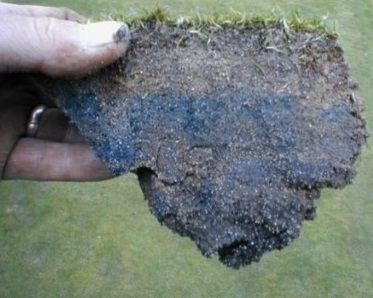
2006, before coring – Typical anaerobic rootzone
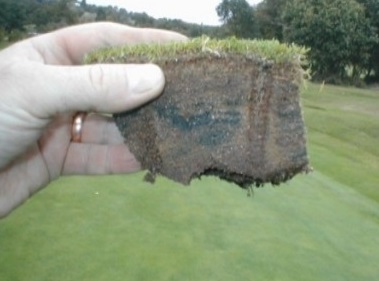
2009, 3 years of coring – black layer still present very close to hollow core holes due to poor oxygen transfer

2011, 2 years of compost tea and microtinning – friable, low thatch, rootzone after applying compost teas and microtinning.
Nature works in several ways to create the correct air and water spaces in the rootzone
Bacteria and fungi produce polysaccharides to help them adhere to surfaces and to prevent them from drying out. The polysaccharides are sticky substances which clump fine soil particles together forming air space in between.
Fungal hyphae grow through the root zone pushing soil particles apart. There is over 1 tonne of fungi per hectare in a healthy root zone and many fungi form mycorrhizal associations to extract and transport nutrients and water through the root zone to benefit the plant.
Nematodes often get a bad press from turf managers but relatively few are plant parasitic. Most live in soil on bacteria and fungi or other nematodes. Nematodes play an important role in soil improvement they are like small worms up to 0.5mm long and as they move through the root zone they push soil particles apart, depositing ammonium as they go. Root hairs then colonise the space and further improve friability.
Earthworms most of which do not form casts are also create wide air spaces and drainage channels.
Composting thatch on the green
Thatch is mostly lignin which needs fungi and actinomycetes to digest it and break it down. You can see this from the attached picture Figure 2. A green with very deep, dense thatch was hollow cored twice a year for two years, regularly tinned and 200 tonnes/hectare p.a. of sand applied. With almost no positive result. After two years the greenkeeper switched to a biological approach. He applied Symbio Thatch Eater, stopped hollow coring, reduced sand inputs to 120 tonnes p.a. and tinned every two weeks with 6ml block tines. After two years of this regime the thatch had almost completely gone leaving an aerated, friable root zone.
Figure 2
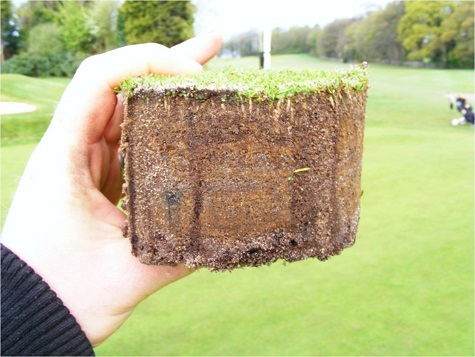
Almost no thatch reduction after two years of hollow coring and 200 tonnes top dressing p.a.

Thatch has disappeared 2 years after application of Symbio ThatchEater and 120 tonnes top dressing p.a.
Creating a fast draining root zone
To naturally maintain free draining rootzones you need a minimum of 2-2.5% w/w humus or humic compounds in the rootzone and until the thatch is completely mineralised which can take up to 30 years humic compounds show up on the loss on ignition test to measure “organic matter”.
The positive effect of humus cannot be overemphasised. It turns the rootzone to a rich brown colour so it is easy to see if you have enough.
Figure 3 below shows the speed with which the transformation can take place, the pictures were taken just 60 days apart in April and June 2018 at Greenburn Golf Club in a fairly wet area of Scotland, aeration was provided by solid 8mm tines and small spikes together with Symbio Liquid Aeration, microbial inoculants and biostimulants.
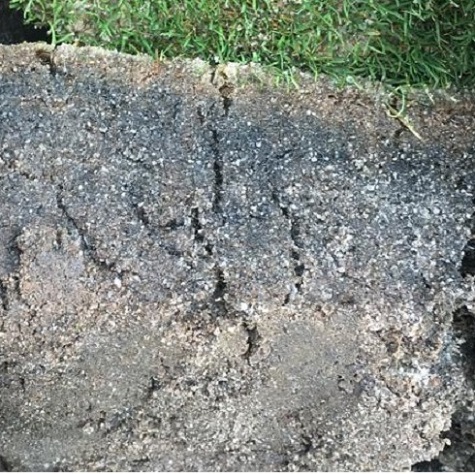
Conventional management after a wet winter 3.4.2018
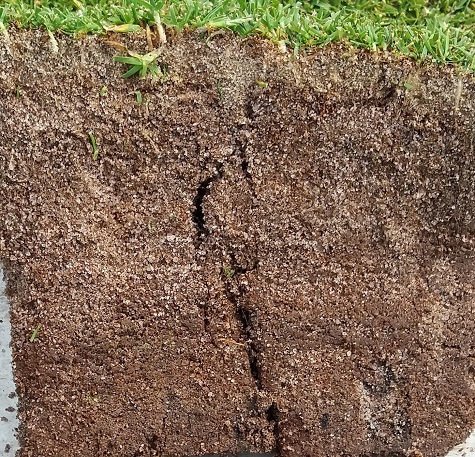
Humus rich, well draining, rootzone 2 after just 2 months of microbial management and solid tines
Figure 4 below shows the improvement in rootzone and root depth that takes place when an old top dressed rootzone converts from purely physical and chemical management to a holistic approach incorporating soil biology with the use of microbial products and biostimulants from Symbio.

Heavy compact rootzone with conventional management
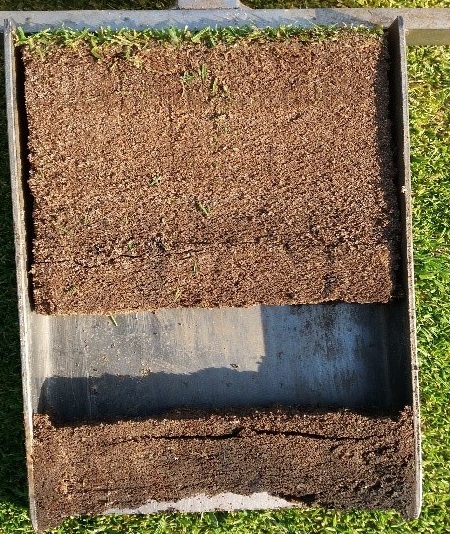
Free draining rootzone with extended rootsystem with solid tines and biological management
Golfers and sportsmen demand the highest standards with minimal disruption, so managing our playing surfaces in the most cost efficient manner is paramount.
If we take a look at the savings made when managing healthy soil we can see that potential savings on 100 tonnes or more of top dressing a year, the reduced investment in machinery and blade maintenance, reduced course closures, more efficient use of man power, reduced fertiliser and fungicide use and more green fee income taken together with the abolition of “maintenance week” will make a sizeable improvement to almost every clubs' finances.
 |
|
|
|